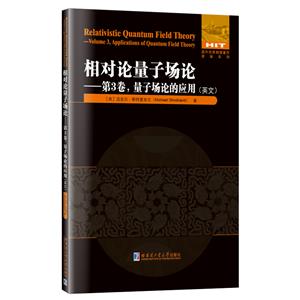扫一扫
关注中图网
官方微博
本类五星书更多>
-
>
宇宙、量子和人类心灵
-
>
考研数学专题练1200题
-
>
希格斯:“上帝粒子”的发明与发现
-
>
神农架叠层石:10多亿年前远古海洋微生物建造的大堡礁
-
>
二十四史天文志校注(上中下)
-
>
声音简史
-
>
浪漫地理学:追寻崇高景观
相对论量子场论——第3卷,量子场论的应用(英文) 版权信息
- ISBN:9787576707496
- 条形码:9787576707496 ; 978-7-5767-0749-6
- 装帧:平装-胶订
- 册数:暂无
- 重量:暂无
- 所属分类:>>
相对论量子场论——第3卷,量子场论的应用(英文) 内容简介
本书是一套从国外引进的英文影印版的多卷本量子力学专著中的一卷。第1卷介绍了经典场和典范量化方法,以便为专注于凝聚态物理学的学生使用的语言和形式论搭建一座桥梁,第2卷以第1卷所学内容为基础,但重新使用了现代路径积分形式,重点关注量子电动力学和色动力学的应用,第3卷继续讨论粒子物理现象学、弱相互作用、希格斯机制和有限温度场论的应用。
相对论量子场论——第3卷,量子场论的应用(英文) 目录
Preface
Acknowledgements
Author biography
Units and conventions
1 QCD phenomenology
1.1 Electron-muon scattering
1.2 Form factors
1.3 Elastic electron-proton scattering and the proton form factors
1.4 Inelastic electron-proton scattering
1.5 The parton model and Bjorken scaling
1.6 Valence partons and sea partons
1.7 Beyond the naive parton model
1.7.1 Gluon emission cross section
1.7.2 Small-angle approximation
1.7.3 Embedding γ*-parton scattering in DIS
1.8 DGLAP evolution
1.9 Hadron production in e*e- collisions
1.10 Fragmentation functions
1.11 Solution of the DGLAP equations using Mellin moments
1.12 Drell-Yan scattering
References
2 Weak interactions
2.1 Early models of the weak interaction
2.2 Muon decay
2.3 Charged pion decay
2.4 Electron-neutrino and electron-antineutrino scattering
2.5 Neutrino-quark scattering
2.5.1 Charge raising current
2.5.2 Charge lowering current
2.5.3 Differential cross section
2.5.4 Embedding
2.6 Weak neutral currents
2.7 The Cabibbo angle and the CKM matrix
2.7.1 The Cabibbo-Kobayashi-Maskawa (CKM) matrix
References
3 Electroweak unification and the Higgs mechanism
3.1 Electroweak Feynman rules
3.2 Massive gauge fields with local gauge symmetry
3.2.1 Spontaneous symmetry breaking
3.2.2 Breaking of a continuous local symmetry
3.3 Gauge boson masses in SU(2)L X U(1)γ
3.3.1 The resulting particle spectrum
3.3.2 Fermion masses
3.4 The discovery of the Higgs boson
3.4.1 The H →γγ decay channel
3.4.2 The H →ZZ → 41 decay channel
3.4.3 The H → τ+τ- decay channel
3.4.4 Other decay channels and the nature of the Higgs
References
4 Basics of f'mite temperature quantum field theory
4.1 Partition function for a quantum harmonic oscillator
4.1.1 The QHO canonical partition function in the energy basis
4.1.2 Computing the QHO partition function using the path integral formalism
4.2 The partition function for a free scalar field theory
4.2.1 Fourier representation of the fields
4.2.2 Tricks for evaluating sum-integrals
4.3 Free scalar thermodynamics
4.3.1 Low temperature limit
4.3.2 High-temperature limit
4.4 The need for resummation
4.5 Perturbative expansion of thermodynamics for a scalar field theory
4.5.1 One loop
4.5.2 Two loops
4.5.3 Three loops
4.5.4 Pressure through g5
4.6 Screened perturbation theory
4.6.1 One-loop contribution
4.6.2 Two-loop contribution
4.6.3 Three-loop contribution
4.6.4 Pressure to three loops
4.6.5 Mass prescription
4.6.6 The tadpole mass prescription
4.6.7 Three-loop SPT Pressure
References
5 Hard-thermal-loops for QED and QCD
5.1 Photon polarization tensor
5.1.1 Generalization to d-dimensions
5.1.2 The HTL polarization tensor
5.1.3 Generalization to QCD
5.2 Fermionic self-energy
5.3 Collective modes
5.3.1 Gluon modes
5.3.2 Quark modes
5.3.3 Collective modes in an isotropic QGP
5.3.4 Gluon modes
5.3.5 Landau damping
5.3.6 Quark modes
5.4 Hard-thermal-loop effective action
5.4.1 Minkowski-space HTL gluon propagator
5.4.2 Minkowski-space HTL quark propagator
5.4.3 Three-gluon vertex
5.4.4 Four-gluon vertex
5.4.5 Quark-gluon three-vertex
5.4.6 Quark-gluon four-vertex
5.4.7 Hard thermal loop effective Lagrangian
5.4.8 Euclidean space HTL effective Lagrangian and vertex functions
5.5 Hard-thermal-loop resummed thermodynamics
5.5.1 Contributions to the HTLpt thermodynamic potential through NNLO
5.5.2 NNLO HTLpt thermodynamic potential
5.5.3 NNLO result for equal chemical potentials
5.5.4 NNLO result--gengral case
5.5.5 Mass prescription
5.5.6 Thermodynamic functions and susceptibilities
5.5.7 Quark number susceptibilities
5.5.8 Baryon number susceptibilities
References
编辑手记
展开全部
书友推荐
- >
中国历史的瞬间
中国历史的瞬间
¥16.7¥38.0 - >
唐代进士录
唐代进士录
¥25.5¥39.8 - >
伯纳黛特,你要去哪(2021新版)
伯纳黛特,你要去哪(2021新版)
¥15.9¥49.8 - >
山海经
山海经
¥19.7¥68.0 - >
姑妈的宝刀
姑妈的宝刀
¥9.0¥30.0 - >
中国人在乌苏里边疆区:历史与人类学概述
中国人在乌苏里边疆区:历史与人类学概述
¥34.1¥48.0 - >
随园食单
随园食单
¥15.4¥48.0 - >
巴金-再思录
巴金-再思录
¥14.7¥46.0
本类畅销
-
怎样解题
¥17.2¥29 -
自然哲学的数学原理-拟定经典力学世界图景的旷世巨典-全新修订本
¥39.4¥58 -
数学-应用与思考
¥16.1¥32.8 -
数学万花筒 修订版
¥32.4¥49 -
数学万花筒-夏尔摩斯探案集-3
¥30.1¥39 -
新型元启发式算法及其应用
¥77.4¥98





















